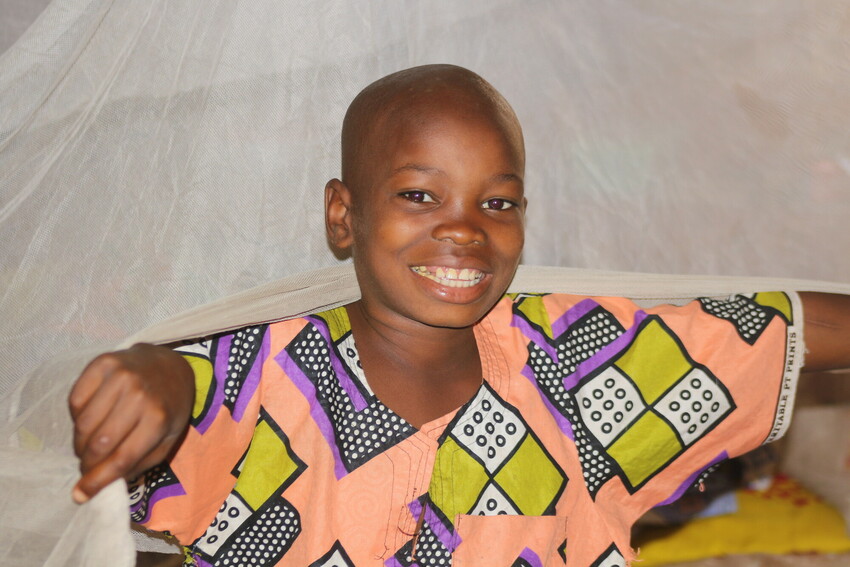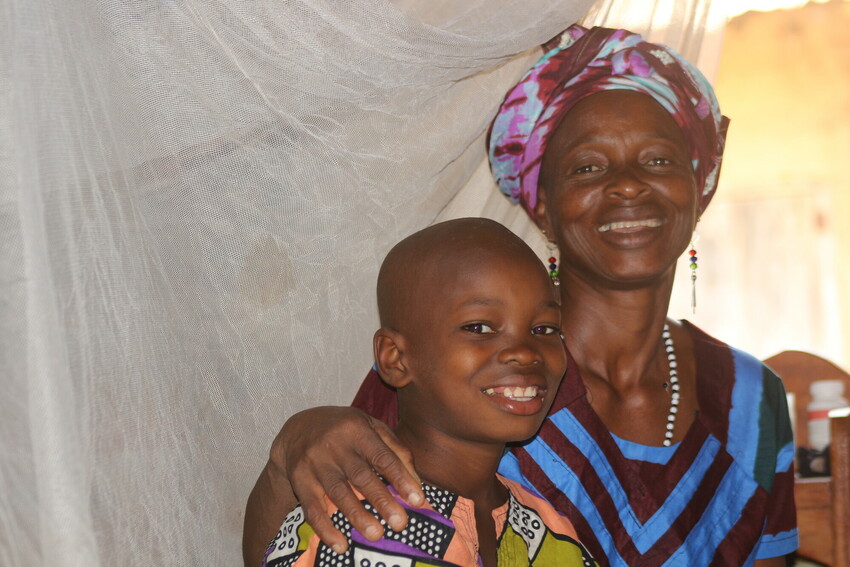
Karifa, 8, shows off his new mosquito net.
Karifa hates the sound of mosquitoes.
“They not only spoil my sleep in the night, but they also bite me, leaving marks all over my body,” the third-grader says. But mosquitoes are more than an irritation for kids like him. They’re the harbingers of a deadly bloodborne disease that has tormented children in tropical and subtropical climates for centuries: malaria.
On October 6, 2021, the World Health Organization (WHO) announced its approval of the world’s first-ever malaria vaccine for children and adults – an enormous milestone. Despite this achievement, sub-Saharan Africa and other regions with high rates of transmission are still on a long, bumpy road to freedom from the disease. It will take time before the vaccine reaches the remotest communities – like Karifa’s in Koinadugu District, a two-hour journey by road from the nearest town.
Karifa doesn’t have time to wait. He may be only 8 years old, but he has big dreams of becoming the president of Sierra Leone one day. “When I become president, I will help my people,’’ he says.
The burden of malaria
At best, malaria is a regular nuisance for children where Karifa lives, an excruciatingly painful interruption from school, play and all a child’s other activities. The classic malaria attack lasts anywhere from six to 10 hours. It includes a “cold stage,” in which patients feel chills; a “hot stage” with fever, headaches, vomiting and even seizures; and a “sweating stage,” after which patients return to a normal body temperature, with lingering fatigue.“Malaria makes me weak,” Karifa says. “[Before], each time I fell ill with malaria, my body ached, and I had frequent headaches and fever. I have been absent from school many times.”
At worst, it’s fatal. In Sierra Leone, malaria remains the leading cause of ill health and deaths among children and pregnant women. According to the National Malaria Control Program, malaria accounts for nearly 40% of the disease burden among all outpatient visits and an estimated 1,000 deaths annually among children under age 5.
“Karifa falling ill to malaria is one of my greatest fears,” says Karifa’s mom, Tata. “He loses his appetite, he loses weight and he becomes pale. His eyes turn yellow; his body temperature becomes very high.”
But malaria’s impact extends beyond considerations of health or even education. For families experiencing poverty, malaria is downright expensive. Families often have to choose between eating or buying medicine for their children.
“One day, I saw my mother count money to take me to the hospital. When we were returning home, she had nothing left,’’ Karifa says.
Tata remembers that day, too. “That day I took Karifa to the hospital, I spent up to 80,000 leones ($6.84) from the little savings from selling my produce,” she says. “After spending that money, the home [was] strained a little bit. But my child’s health is important to me.
“Another time, I had to travel with him all the way to Kabala town for treatment. He was shivering on the way. By the time we got there, Karifa had already thrown up three times on the motorbike because of the bad road.
“That day, I also had a severe headache. When we got to the clinic, it turned out I had malaria, too. I spent 150,000 leones ($12.83) on treatment and an extra 70,000 leones ($5.99) on transportation to and from Kabala.” For families who are making less than $1.90 per day, these are enormous costs.
The good news is that malaria’s burden is completely preventable – and not only with a vaccine. The next best thing is a simple mosquito net.

Karifa and Tata.
Surviving malaria
In 2018, ChildFund, in collaboration with its local partners in Sierra Leone and the National Malaria Control Program, launched a new initiative to help prevent malaria by delivering long-lasting insecticide-treated mosquito nets to children at their schools. As their name implies, the mosquito nets are treated with a special insecticide to protect children from malaria-carrying mosquitoes while they sleep. It was through this program that Karifa got his very first net in November 2021.
“I received two nets,” says Karifa. “I share one with my two siblings. The other net is being used by our mother. I have not fallen ill with malaria since using the net.’’
The initiative has since delivered 72,000 mosquito nets, along with education on their correct handling and continuous use, to schoolchildren in hard-to-reach communities in Kailahun, Bombali, Falaba, Koinadugu, Bo and Moyamba districts in Sierra Leone.
Is it working? The numbers tell the story. In December 2021, Karifa’s community reported 58 new cases of malaria. As of February 17, 2022, new cases had dropped to 28. This means that malaria cases in Karifa’s community dropped by 51.72% within a few months after the mosquito nets were delivered.
But it’s not enough to simply provide the mosquito nets to children. Malaria prevention must go hand in hand with community participation.
“Although ChildFund and [its local partner organization] Daindemben Federation are helping us in this community, we still feel we should also be responsible for our own health,” says Mohamed, the chief in Karifa’s community. “Mosquitoes have taught us a lesson in this community. Even I was falling sick with malaria very frequently. I have spent money to get treatments for me and my family in the past.”
The school-based prevention program emphasizes communities’ adherence to malaria prevention measures. After all, environmental conditions also play an important role in the transmission of the disease. For example, standing water can produce a breeding ground for mosquitoes. Regulation of environmental conditions like these can help to reduce disease burden.
Local people themselves are crucial to spreading these messages, so ChildFund and its partners have trained more than 350 volunteers in the targeted communities to help spread the word about malaria prevention and control.
“People from Daindemben Federation come here to talk to us about cleaning our environment,” says Karifa. “I live next door to Lansana, a community volunteer at Daindemben Federation. He regularly checks on us to make sure we are using the nets and cleaning our spaces.
“I pray I don’t go to the hospital again for malaria, which is why I am so happy about the net given to us by ChildFund,” says Karifa. “I always ensure that the nets are down and properly tucked in before going to bed.”
This World Malaria Day, ChildFund remains committed to helping children and their families overcome the challenges posed by this pervasive disease. We look forward to the day the malaria vaccine for children will be available even in the most remote communities – including Karifa’s. It might just be the game changer we have all been waiting for.





